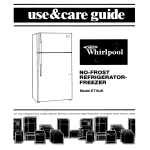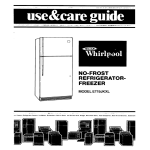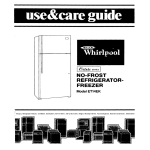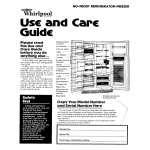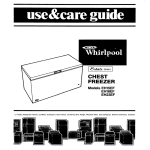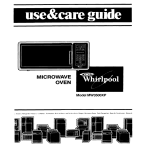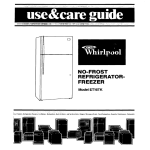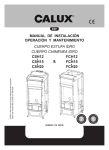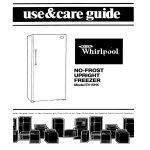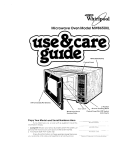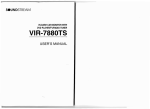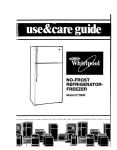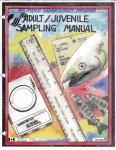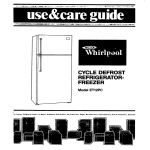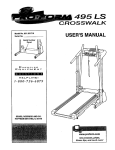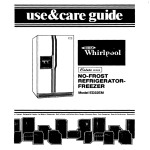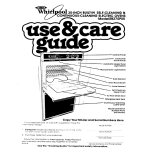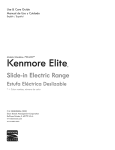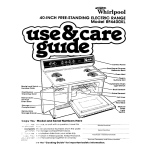Download Whirlpool ETl2EC User's Manual
Transcript
1 &h-hi SERIES 1 CYCLE DEFROST REFRIGERATORFREEZER Model ETl2EC ;. freezers, Refrigerator-freezers. Ice Makers, Dishwashers, Built-In Ovens and Surlace Units, Ranges. Microwave Ovens. Trash Compactors. Room Air Conditboners. Dehumidiliel Please read this Use and Care Guide before you do anything else.. l This booklet tells you how to start your refrigerator, clean it. move shelves and adjust controls. It even tells you what new sounds to expect from your refrigerator. Treat your new refrigerator with care. Use it only to do what home refrigerators are designed to do. Parts and features Rack Egg Nest Trays Butter Light y Temperature’ Control Power Saving Control / Model and ;er;“,l Number. Levelling Leg I Copy your Model and Serial Numbers When you need service o( call with a question, have this information ready: here.. . Model Number 1. Complete Model and Serial Numbers (from the plate located as shown). Serial Number 2. Purchase daie from sales slip. Purchase Date Copy this information in these spaces. Keep this book, your warranty and sales slip together in a handy place. 2 Service Company and Telephone Number Contents Page SAFETY FIRST BEFORE YOU PLUG IT IN. Install Properly Level Refrigerator-Freezer Remove Sales Labels Clean It Plug It In USING YOUR REFRIGERATOR. Setting the Control Power Saving Control Adjusting the Shelves Removing Crisper and Crisper Cover Changing the Light Bulb Ice Cube Trays 3 3 4 4 4 4 4 5 5 5” 5 6 6 Sounds You May Hear, Energy Saving Tips CLEANING YOUR REFRIGERATOR Defrosting the Freezer. Cleaning Chart FOOD STORAGE GUIDE. Storing Fresh Food Storing Frozen Food VACATION AND MOVING CARE IF YOU NEED SERVICE OR ASSISTANCE 1. Before Calling For Assistance 2. If You Need Assistance 3.IfYouNeedService ,,,,,.,,,,,.,,, 4. If You Have a Problem 01985 Whirlpool Page 6 6 7 7 8 9 9 10 10 11 11 11 11 11 Corporation Before you plug it in IMPORTANT Before using your refrrgerator. you are personally responsible for making sure that It l IS installed and leveled on a floor that will hold the weight, and in an area suitable for Its srze and use l IS connected only to the right kind of outlet, with the right electrrc supply and grounding. l is used only for jobs expected of home refrigerators. l IS not near an oven, radrator or other heat source. properly maintained. is out of the weather. 0 IS used in an area where the room temperature WIII not fall below 55 F (13” C). l is not run where there are explosive fumes. l IS not used by children or others who may not understand how it should be used. l is not loaded with food before It has time to get properly cold. l IS l 3 Install properly.. . Remove sales labels.. . Remove the Consumer Buy Guide label, tape and any inside labels before using the refngerator. To remove any remaining glue: 1 Rub briskly with thumb to make a ball then remove. OR 2 Soak area with dishwashing detergent solution (1 teaspoon detergent in 1 quart warm water] before removing glue as described in step 1 DO NOT USE rubbing alcohol or flammable or toxic solvents, such as acetone, gasoline, carbon tetrachloride, etc. These can damage the material. NOTE: DO NOT REMOVE ANY PERMANENT INSTRUCTION LABELS INSIDE YOUR REFRIGERATOR. Do not remove the Tech Sheet fastened under the refrigerator at the front. Clean it.. . \u 1. Allow 3 Inches (7 5 cm) between overhead cabinets and the refrigerator top 2 Allow at least an inch (2 5cm) between the refrlgerator condenser and the wall. 3. You don’t need space between counters and cabinets and the refrigerator sides. For ease of ~nstallation,you might wanttoleaveenough room (‘1~ inch - 1.25 cm) so the refrigerator can be moved easily. 4. If the refrigerator ISto be against a wall. you might want to leave enough space so the door can be opened wider. Clean your refrigerator before using It. See cleanlnq instructions onpage7. - @ I . A Plug it in... J-prong grounding type wall receptacle Level refrigerator-freezer... 0x4 ng Plug Retrigbotor Power Cord RECOMMENDED GROUNDING METHOD Levelli Raise lower I, Keep the 4 bolts that hold refrigerator and shipping crate. They are the levelling legs. 2. Screw these bolts all the way into bolt holes at the bottom corners of refrigerator. 3. Adjust each leg until the refrigerator won’t rock. Slide refrigerator into place. 4. Adjust front legs to level the refrigerator. -To raise corners, turn legs clockwise. -To lower corners, turn legs counterclockwise. 5. Check with level. 4 A 115 Volt, 60 Hz.. AC only 15 or 20 ampere fused and properly grounded electrical supply is required. It is recommended that a separate circuit serving only this appliance be provided. Do not use an extension cord. Use a receptacle which cannot be turned off with a switch or pull chain. See individual electrical requirements and grounding instruction sheet in your literature package. Using your refrigerator Control Power Saving I Control Setting the control.. . The Temperature Control IS on a console Inside the refrigerator in the top right corner It controls the temperature in both the refrigerator and freezer. Set the control to Number 3. .l Glve the refrigerator tlme to cool down completely before addrng food. (Thus may take several hours). The control will be set about right when milk or juice is as cold as you like. This setting should be about right for normal household refrigerator usage. Power Saving Control.. . The Power Savlng Control on the Control Console operates electric heaters around the door openings. These heaters help keep moisture from forming on the outside of the refrigerator. Adjusting I. 2. 3. 4. Use the “OFF” setting when humidity is low. Use the “0N”setting if moisture fcfms on the outside of the refrigerator. the shelves... First, remove food from shelf. Slide shelf straight out to stop. Lift front. Slide the rest of the way out. Guide Stop Shell Stop Replacing Shelf: 1, Fit back of shelf on top of guides with wire stops on the bottom of guides. 2. Lift front, slide shelf in until it clears guide stops. Removing crisper and crisper cover... Removing Crisper: Slide crisper straight out. Remove Cover: 1. Lift back, then slide to the rear until the front con be lifted. 2. Lift cover up and out. Replaclng Cover: I, Slide the front cover tabs into the bock of the front supports on the refrigerator wall. 2. Lower back into place. l Lift the Back, Then Slide to Rear and Lifl ‘Shelf Gulde Changing WARNING: the light bulb. . . Before removing the light bulb, either unplug the refrlgerator or disconnect the electricity leading to the refrigerator at the main power supply. Shock and injury can occur if electricity remains connected. I. Reach behind control console to find bulb 2. Remove bulb 3. Rep/me with opphance bulb only Ice cube trays.. . To remove Ice: l Hold tray at both ends l Slightly twist. If cubes are not used, they may shrtnk The movrng cold air starts a slow evaporatron The longer cubes are stored. the smaller they get Sounds you may hear... Your new refrigerator may make sounds that your old one drdn’t Because the sounds are new to you, you might be concerned about them Don’t be Most of the new sounds are normal Hard surfaces like the floor, walls and cabinets can make the sounds seem louder. The followtng chart describes the kinds of sounds that might be new to you, and what may be makrng them l Water Sounds: When the refrigerator stops running. you may hear gurgltng in the tubing for a few minutes after It stops You may also hear defrost water running into the defrost water pan l Running Your refrigerator has a high-effrcrency compressor and motor It ~111run longer than older designs. It may even seem to run most of the time Sounds: Energy saving tips.. . You can help your refrigerator use less electrrcrty. Check door gaskets for a tight seal. Level the cabrnet to be sure of a good seal l Clean the condenser coil regularly l Open the door as few times as possrble. Thank about what you need before you open the door Get everything out at one time. Keep foods organized so you won’t have to search for what you want. Close door as soon as food is removed. l Go ahead and fill up the refrigerator, but don’t overcrowd it so air movement is blocked. l l 6 l l It is a waste of electrrcrty to set the refrigerator and freezer to temperatures colder than they need to be If ice cream IS firm in the freezer and drinks are as cold as your family likes them. that’s cold enough Make sure your refrigerator is not next to a heat source such as a range, water heater. furnace. radiator, or in direct sunlight Keep the Power Saving Control on OFF unless moisture forms on the refrigerator exterior. Cleaning your refrigerator There is a cold plate on the the refrigerator section. When runs, frost collects on the cold turns off, the frost melts. It II The refrrgerator section defrosts automatically. The freezer section needs defrosting from time to time. Both sections should be cleaned about once a month to help prevent odors from building up Of course, spills should be wiped up right away. back wall at the top of the refrigerator motor plate. When the motor Water from this melted frost drips into a drain trough just below the cold plate. Then it runs down the back wall and through the drain just above the crisper. The drain leads to a defrost water pan on the top of the refrigerator motor. Heat from the motor evaporates the water If the drain becomes clogged, force warm water mixed with baking soda through the drain until the water flows freely. To clean your refrigerator, turn the Temperature Control to “OFF” Unplug it, take out all removable parts, and clean it according to the following directions and the chart on page 8. Solution Through Drain Cap Openings. Defrosting the freezer... The freezer section should be defrosted whenever frost builds up to a ‘/4-inch (6 mm) thickness DO NOT USE ANY TYPE OF ELECTRIC DEFROSTER OR SHARP UTENSILS (ICE PICK, KNIFE, ETC.) to speed defrosting. These can cause damage Defrost Drain Put Pan of Hot Water Freezer to Speed Put pan in Refrigerator to Catch Defrost Water. Put empty pan in the refrigerator on the top shelf in the center, Move frozen food and ice to the refrigerator section. Turn the Temperature Control to “OFF.” Close the refrigerator door Leave the freezer door open. Put a pan of hot water in the center of the freezer This helps melt the frost. Don’t place pan over drain hole in center of freezer 6. Defrost water will drain through drain hole into the pan you put in the refrigerator section. You may have to melt frost from the drain hole by pouring a little hot water around it. 7 Wash the inside of the freezer with a solution of 2 tablespoons (30 mg) of baking soda and one quart (IL] warm water Rinse well and dry a#, Remove the pan of defrost water from the refrigerator; put frozen food and ice back intc freezer 9. Reset the Temperature Control. Cleaning chart.. . Part what Removable parts [shelves, crisper. ), Sponge or cloth; mild detergent and warm water. Outside to use How to clean Sponge, cloth or paper towel; mild detergent, appliance wax (or good auto paste wax) Waxing lnsrde walls [Freezer should be allowed to warm up so cloth won’t stick ] painted metal Sponge, soft cloth or paper towel, bakrng soda, warm water, mild detergent Wash removable parts with warm water and a mild detergent. Rinse and dry. l l Wash wrth warm water and a mild detergent Do not use abrasive or harsh cleansers. l Rinse and dry l Wax painted metal surfaces at least twice a year with applrance wax or a good auto paste wax. Apply wax with a clean, soft cloth. Do not use wax on plastic parts. surfaces provides rust protectton. l Wash wrth warm waler and - mild detergent or - baking soda (2 tablespoons 1 quart (95 I) warm water Rinse and dry l l DOCXliners and gaskets Sponge, soft cloth or paper towel, mild detergent, warm water DO NOT USE Cleanlng bleaches or cleansers Mild detergent and warm water, soft, clean sponge and soft, clean cloth Dark oanels Wash with mild detergent water Rinse and dry l l waxes, concentrated contalnlng petroleum l l detergents, on plastic (26 g ] to and warm parts. Wash with a soft g&free cloth or sponge Rinse and dry with a damp grit-free cloth or chamois DO NOT USE paper towels, wlndow sprays, scouring cleansers, or solvents llke acetone, benzlne, carbon tetrachlorlde, etc. These can scratch or damage the material. Defrost pan [behind refrigerator on top of the motor] Sponge. cloth or paper towel; warm water and mild detergent. l l l l l Condenser Co11 Use vacuum cleaner with brush attachment l l Slide refrigerator out away from wall. Wash defrost pan with warm water and mild detergent. Do not remove defrost pan to clean. Rinse and dry. Make sure defrost drain tube points into pan. Slide refrigerator back into place. Clean dust and lint from condenser coils on back of the refrigerator at least every other month. Leave one Inch (2 5 cm] between wall and condenser coil on back of the refrrgerator Food storage guide STORING FRESH FOOD Cured or Smoked Meat and Cold Cuts. Ham, bacon, sausage, cold cuts, etc., keep best in original wrappings. Once opened, tightly re-wrap in plastic wrap or aluminum foil. Canned Ham. Store in refrigerator unless the label says it’s okay to store on the shelf. Do not freeze. Fresh Pouitry...Wrap in plastic wrap. The plastic wrap on poultry, as purchased, may be used for STORAGECHARTFOR FRESHAND WRED MEAT* VP. There IS a right way to package and store refrigerated or frozen foods To keep foods fresher. longer, take the time to study these recommended steps Leafy Vegetables.. Remove the store wrapping and trim or tear off bruised and discolored areas Wash in cool water, drain and store in crisper, Vegetables with Skins [carrots, peppers). .Store In crisper, plastic bags or plastrc container. Fruits .Wash, let dry and store In refrigerator In plastic bags or crisper. Do not wash or hull berries until they are ready to use. Sort and keep berries In their store contarner In a crisper. or store In a loosely closed paper bag on a refrigerator shelf A~roxlmatoTbno (-w Variety Meaf!r . . . . . . . . . . . . . . . . . . . . 1 to2 Chfcken . . . . . . . . . . . . . . . . . . . . . . . . . . 1 to2 GroundBeef . . . . . . . . . . . . . . . . . . . . . . 1 to2 Steaks and Roasts . . . . . . . . . . . . . . . . 3 to 5 Cured Meats . . . . . . . . . . . . . . . . . . . . . 7 to10 Bacon . . . . . . . . . . . . . . . . . . . . . . . . . . . . St07 coictcuts . . . . . . . . . . . . . . . . . . . . . . . . 3 to5 ‘If meat is to be stored longer than the times given, follow the directions for freezing. NOTE: Fresh fish and shellfish should be used the same day as purchased. Store without washing in the original Eggs carton or use the egg nest in the door of your refrigerator Mllk...Wipe milk cartons. For best storage, place Meat* .Meat ISperishable and expensive...you milk on Interior shelf. won’t want to waste an ounce of It through careless Beverages.. Wipe bottles and cans. Store on a handling. The followrng list and chart give you packdoor shelf or Inside the refrigerator aging hints and time limits. Butter Keep opened butter In covered dish or In Fresh, Prepackaged Meat. Store fresh meat In the Butter Compartment. When storing an extra supthe store wrapping. Vacuum packaged meat can ply, wrap in freezer packaging and freeze. be frozen for as long as one month If the seal is not Cheese .Store in the original wrapping until broken. If you want to keep it frozen longer, you you are ready to use it. Once opened, re-wrap should wrap it wrth special freezer wrapping material tightly in plastic wrap or aluminum foil. Condlments .Store small jars and bottles (catFresh Meat, Not Prepackaged. Remove the market wrapping paper and re-wrap in aluminum foil sup, mustard, jelly, olives] on the door shelves where they are in easy reach. for storing it unfrozen. Leftovers...Cover leftovers with plastic wrap or Cooked Meat. Wrap or cover cooked meat with aluminum foil to keep food from drying out and plastic wrap or aluminum foil. Store immediately transferring food odors. Plastic containers with tight lids are fine, too. STORING FROZEN FOOD The freezer section IS deslgned for storage of corn merclclly frozen foods aqd for freerlng foods or home Packaged Frozen Food Store on freezer door shelf or In the freezer If you plan to store It for a long time. re-wrap 11with aluminum foil or plastic wrap Frozen MeatsThe followlng hints WI// help keep the quollty lr your frozen meats 1. Freeze meat while fresh and In top condltlon 2. Use only recommended wrapplng materials 3. Prepare the meat for freezlng before wrapping It Trim off excess fat and remove bones when practical Meat should not be salted because salt shortens freezer ltfe 4. Wrap tlghtlk, pressing out OS much olr as oossible 5. Label and date tt 6. Refreezing thawed meat 8snot recommended Frozen Soups, Juices Store on freezer door shelf or In the freezer Packaging The secret of successful freeztng IS In the pockagIng The wrap you use must be air, motsture and vapor proof The way you close and seal the package must not allow olr moisture or vapors or. or ou’ Rigid polyetPy;lene (piost CI contolners ‘wth tightflttlng IIds strc?lgh’-sided canning freezing jars. heavy-duty alurnlnum foil, plastic-cwted paper and non-permeable plastic wraps (such as Saran) are recommended Note Heat-sealed boiling bags are or as easy to use an71 can be used by themselves carton liners IMPORTANT: Do not expect your treezer to qulckfreeze any large quantlty of food. leave enough space for air to circulate around packages. Be careful to leave enough room at the front so the door can close tlghtly. store IP the freezer Once the packIce Cream cage IS opened place 0 piece of olumlnum fol or &axed paper smoothly against the Ice cream surf ‘ace This will prevent ice crystals from forming STORAGECHARTFOR FROZENFOOD times given in this chart are only a guide. For best use of freezer space, keep frozen foods for shcxt times. Use, then replace as needed. 2months Bread .......................... 2-3 months Cooked Dishes ............... Fish and Seafoods 6months Fresh ......................... l-3 months Commercially Frozen ...... 6months Fruits ........................... 1 month Ice Cream ....................... 4-6 months Concentrated Juice .......... Meats Less than 1 month Bacon ................ 3-4 months Pork roasts, chops .......... 1-2 months Sausage .................... 6 months Beef, veal, lamb roasts ....... . l-2 months Ground meat ............... 3-4 months Poultry ..................... 6months .................... Vegetables Storage .Courtesy .Courtesy of Natlonol of U S D A _Ive Stock and Meat Board Vacation and moving care Short vacations. .. No need to shut off the refrlgerotor II you ~111 be away for less than four weeks Use up rserlshobles freeze other Items Long vacations. Remove or more all the food .. If you are going Unplug the refrigerator and clean It rlnSe well and dry Tape rubber or wo& blocks to both doors keeping them open far enough for air to get In This WIII keep odor and mold from bulldIng up WARNING: for a month To restart 10 Tape blocks out reach...do not allow the retrlgerator when blocked open. They Injured or trapped. refrigerator. see “Using of a child’s children near the doors are may become Your Refrtgerator Moving. .. Remove all fad. Pack frozen foods in dry Ice. Unplug the refrigerator and clean it thoroughly Remove everything that comes out. Wrap all parts well and tape them together so they don’t shift and rattle. If you need service or assistance, we suggest vou follow these four stem: 1. Before calling for assistance.. . Performance problems often result from IMe things you can find and fix yourself wlthout tools of any kind If your refrigerator will not operate: Is the electric cord plugged in? l Is a fuse blown or a circuit breaker tripped? l Is the Temperature Control turned ON? l If there is a rattling or jingling noise, or other unfamiliar sounds: l Is something on top or behlnd the refrigerator makIng noise when the refrigerator is running? If there is water in the defrost pan: In hot, muggy weather, this IS normal The pan can even be half full. Make sure the refrigerator is level so the pan doesn’t overflow l If the light doesn’t work: l Check fuses and circuit plugged in. breakers Make Screw in the levelling legs: tape the doors shut; tape the electric cord to the cabinet. When you get to your new home, put everything back, level it, and refer to page 4. and talk with one of our trained Consultants. The Consultant can instruct you in how to obtain satisfactory operation from your appliance oT, If service is necessary, recommend a qualified service company in your area 3. lf you need service”... Whirlpool has a nationwide network of franchised TECH-CARE@ Service Companies TECH-CARE service technicians are trained to fulfill the product warranty and provide after-warranty service, 1 FRANCHlSEDSERVICE I anywhere in the United To locate States TECH-CARE service In your area. call our COOL-LINE service assistance telephone number [see Step 2) or look in your telephone directory Yellow Pages under: ELECTRICAL MAJOR- APPLIANCES-HOUSEHOLDMAJORSERVICE 6 REPAIR APPLIANCESREPAIRING 6 PARTS ‘JR WHIRLPOOLAPPLIANCES FRANCHISED TECH-CARE SERVICE WHIRLPOOL APPLIANCES FRANCHISED TECH.CARE SERVICE SERVICE XYZ SERVICE co 123 MaDIe SERVICE XYZ SERVICE CO 123 Maple COMPANIES 999.9999 COMPANIES 999.9999 OR sure it’s WASHING MACHINES, DRYERS 6 IRONERSSERVICING If a bulb is burned out: l S&e instructions for changing light bulbs on page 6 Use appliance bulbs only. WHIRLPOOL APPLIANCES FRANCHISED TECH-CARE SERVICE SERVICE XYZ SERVICE CO 123 Maple 999.9999 COMPANIES 4. If you have a problem * . . . If the motor seems to run too much: l Is the condenser free of dust and lint? l On hot days, OT if the room is warm, the motor naturally runs longer. l If the door has been opened a lot, or if a large amount of food has been put in. the motor WIII run longer to cool down the interior. Remember: Motor running time depends on different things: number of door openings, amount of food stored, temperature of the room, setting of the controls. Call our COOL-LINE service assistance telephone number (see Step 2) and talk with one of our Consultants, or if you prefer, write to Mr. Stephen E. Upton Senior Vice President Whirlpool Corporation Administrative Center 2OOOllS-33 North Benton Harbor, MI 49022 -If you must call or write, please provide: rndel number, serial number, date of purchase, and a complete description of the problem. This information is needed in order to better respond to your request for assistance 2. If you need assistance*... Call Whlrlpool COOL-LINE. service asslstance telephone number. Dial free from: Contlnental U.S. . . . . . . . . . . . . (800) 253-1301 Mlchfgan . . . . . . . . . . . . . . . . . . . (800) 632-2243 Alaska 81Hawall . . . . . . . . . . . (800)253-1121 0 FSP aB FSP IS a registered trademark of Whrrtpcwl Corporotlon for qualrh/ parts Look for lhts sYmbol of qualrty whenever you need a replacement part for your Whrrtpool appliance FSP replacement parts WIII RI rrghl and work right.. because they are made to tne same exacting specrficatlons used to butld ever-~ new Whlrlpoo applrance TKirlpool Home L /Appliances Making your world a little easier. Part No. 1104914 01985 Whirlpool Corporation Makers, Dishwashers. Bu~ll-In Ovens and Surface Printed in U.S.A. Units. Ranges. Microwave Ovens. Trash Compactors, Room AH Conditioners. Oehumidlliers. Automallc Washers, Clothes Dryer












